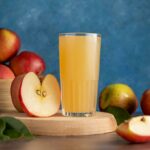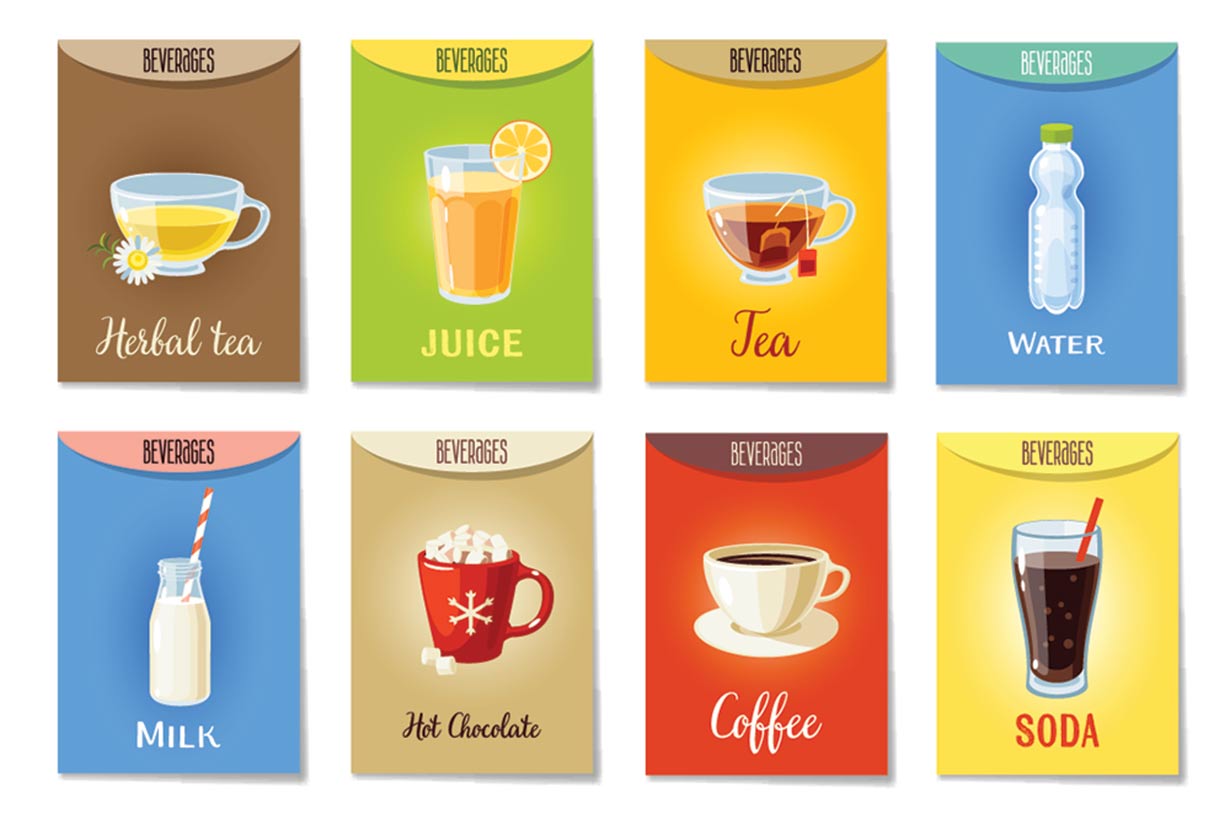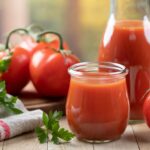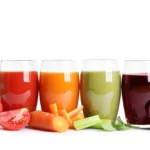When most people think of fruit juice, they think of orange or apple juice.
However, there are many types of fruit juice from a wide variety of different fruits.
This article presents some of the most common fruit juice drinks and their key nutritional values.
Additionally, what are some of the potential benefits and downsides of fruit juice?
Table of contents
How Many Types of Fruit Juice Are There?

In truth, it is possible to make juice from almost any fruit with the right equipment.
However, some fruit juice varieties are more common than others.
For example, it is possible to find apple, cranberry, orange, and pineapple juice in almost any decent-sized grocery store.
This article provides a guide to sixteen of the most common juices, as shown in the table of content. Each of these juices has reputable nutritional data available within the USDA database.
Fruit Juice Varieties
We will now examine sixteen popular types of fruit juice; all juices covered are 100% pure, fresh juice.
In other words, they contain no added ingredients and are not made from concentrate.
You can find general information on each type of juice’s characteristics and nutritional properties.
The source of all nutritional data is the USDA’s FoodData Central database.
All daily values (% DV) have been calculated using USDA data and the FDA’s recommended daily values.
1) Apple Juice
Apple juice is a sweet drink with a cloudy, translucent yellow color.
Compared to other types of juice, apple juice contains a relatively high sugar content, which explains its sweet taste.
A 248g cup of apple juice provides the following nutritional values (1):
- Calories: 119 kcal
- Carbohydrates: 28.1 g
- Fiber: 0.5 g
- Sugars: 25.1 g
- Fat: 0.62 g
- Protein: 0.22 g
A cup of apple juice also provides a good amount of manganese (8% DV) and potassium (5% DV).
For an in-depth nutritional guide to apple juice, please refer to the following article:
2) Blackberry Juice
Blackberry juice isn’t quite as popular as more common juices like orange and apple.
However, it is increasingly easier to find and has a sweet but slightly tart taste.
Blackberries are also rich in polyphenols, making blackberry juice a concentrated source of these compounds (2, 3).
The following nutrients are present in a 248g cup of blackberry juice (4):
- Calories: 94 kcal
- Carbohydrates: 19.3 g
- Fiber: 0.25 g
- Sugars: 19.1 g
- Fat: 1.49 g
- Protein: 0.74 g
Blackberry juice also provides high amounts of copper (32% DV), vitamin K (32% DV), vitamin C (31% DV), vitamin E (15% DV), magnesium (13% DV), zinc (9% DV), and potassium (7% DV).
3) Blueberry Juice
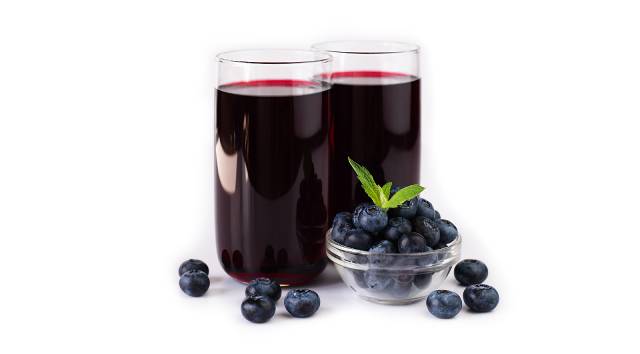
Like blackberry juice, the juice from blueberries has a slightly tart but sweet taste.
Blueberry juice has a deep purple color due to its high levels of anthocyanins (a type of polyphenol) (5).
Per 248g cup, blueberry juice provides the following nutrients (6):
- Calories: 92 kcal
- Carbohydrates: 23.4 g
- Fiber: 3.97 g
- Sugars: 16.0 g
- Fat: 0.52 g
- Protein: 1.19 g
Blueberry juice contains moderately high amounts of vitamin K (26% DV), vitamin C (17% DV), and copper (11% DV).
4) Coconut Water
Despite its ‘coconut water’ name, young green coconuts are categorized as fruit, and the water they contain is their juice.
Coconut water contains various electrolyte minerals, and it is a particularly good source of potassium.
Per 245-gram cup, it provides the following nutritional values (7):
- Calories: 44 kcal
- Carbohydrates: 10.4 g
- Fiber: 0 g
- Sugars: 9.6 g
- Fat: 0 g
- Protein: 0.54 g
For more information, see this guide to coconut water’s nutritional benefits.
5) Cranberry Juice
Cranberry juice has a much tarter flavor than most other fruit juices and contains less sugar.
For this reason, it is easy to find sweetened cranberry juice products on store shelves.
However, the juice is also available in its ‘unsweetened’ form.
Cranberry juice has a deep red color that, like other berry juices, comes from its significant anthocyanin content (8).
A 248g cup of cranberry juice offers the following nutritional values (9):
- Calories: 79 kcal
- Carbohydrates: 18.0 g
- Fiber: 0.25 g
- Sugars: 8.46 g
- Fat: 0.84 g
- Protein: 0 g
Regarding its vitamin and mineral content, cranberry juice supplies a good source of vitamin E (20% DV) and vitamin K (11% DV).
6) Grapefruit Juice
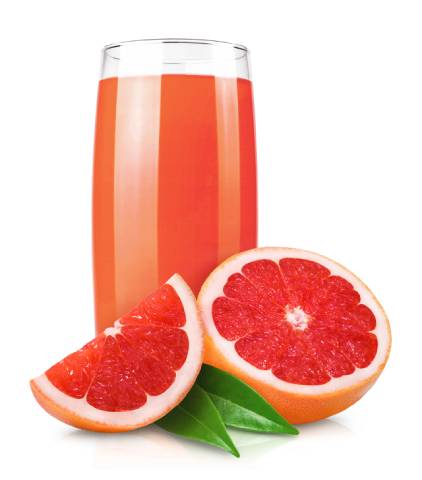
Grapefruit juice is another popular fruit juice with a sweet yet slightly bitter taste.
This bitter taste comes from grapefruit’s naringin content, a bitter-tasting flavonoid polyphenol (10).
Grapefruit juice can come in two colors: white, which is pale yellow, and red/pink, which is the most common.
Here is the nutritional content of a 247g cup of grapefruit juice (11):
- Calories: 97 kcal
- Carbohydrates: 22.8 g
- Fiber: 0.25 g
- Sugars: 22.6 g
- Fat: 0.25 g
- Protein: 1.24 g
Like most citrus fruit, a glass of grapefruit juice is a good source of vitamin C (79% DV).
The juice also contains moderate amounts of potassium (9% DV), magnesium (7% DV), copper (9% DV), and thiamin (8% DV).
7) Grape Juice
Grapes have one of the highest sugar contents among fruit.
This being the case, grape juice has a very sweet taste.
Depending on which type of grape the juice came from, grape juice can be a deep purple or a pale yellow color.
The nutritional content per 253g cup of grape juice is as follows (12):
- Calories: 152 kcal
- Carbohydrates: 37.4 g
- Fiber: 0.51 g
- Sugars: 35.9 g
- Fat: 0.33 g
- Protein: 0.94 g
A cup of grape juice also provides high amounts of manganese (26% DV) and potassium (6% DV).
8) Lemon Juice
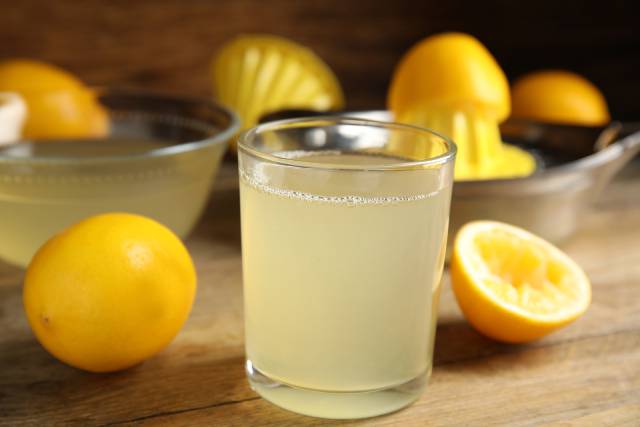
Lemon juice has a cloudy pale yellow color and a sour taste.
This sourness comes from lemons’ high citric acid levels (13).
Unlike other juice drinks, lemon juice has a relatively low sugar content and a lesser-sweet taste.
A typical 244g cup of lemon juice provides the following nutrients (14):
- Calories: 54 kcal
- Carbohydrates: 16.8 g
- Fiber: 0.73 g
- Sugars: 6.15 g
- Fat: 0.59 g
- Protein: 0.85 g
Like other citrus-based juice, lemon juice is rich in vitamin C, with a cup providing 105% of the daily value.
Lemon juice also provides moderate folate (12% DV) and potassium (5% DV) content.
9) Lime Juice
Lemons and limes are pretty similar in their taste and usage.
It is also the case that lime juice has a similar nutritional profile to lemon juice.
Lime juice has a cloudy pale yellow-to-green color and a sour taste.
Like lemon juice, lime juice has a high citric acid content. However, it also has an even lower sugar content than lemon juice.
A 242g cup of lime juice has the following nutritional values (15):
- Calories: 61 kcal
- Carbohydrates: 20.4 g
- Fiber: 0.97 g
- Sugars: 4.09 g
- Fat: 0.17 g
- Protein: 1.02 g
Lime juice is a good source of vitamin C (81% DV), potassium (6% DV), and folate (6% DV).
10) Orange Juice
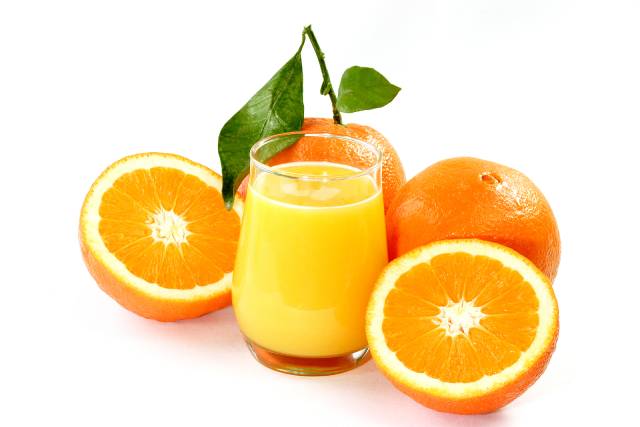
Orange Juice is the most popular juice globally and sells more than other fruit juices (16).
It is also one of the sweetest fruit juice drinks, with a relatively high sugar content.
A 248g cup of orange juice offers the following nutritional profile (17):
- Calories: 112 kcal
- Carbohydrates: 25.8 g
- Fiber: 0.5 g
- Sugars: 20.8 g
- Fat: 0.5 g
- Protein: 1.74 g
Orange juice provides a decent amount of several vitamins and minerals per cup, including vitamin C (138% DV), thiamin (18% DV), folate (19% DV), potassium (11% DV), and magnesium (6% DV).
11) Pineapple Juice
Pineapple juice has one of the highest sugar contents among juice.
The drink has a sweet and fruity but slightly tart taste.
Pineapple juice is widespread and is among the most common commercially available fruit juices.
A 250g cup of pineapple juice has the following nutrient profile (18):
- Calories: 132 kcal
- Carbohydrates: 32.2 g
- Fiber: 0.5 g
- Sugars: 25.0 g
- Fat: 0.3 g
- Protein: 0.9 g
Notably, pineapple juice is one of the most nutrient-rich fruit juice options.
In this regard, a cup serving provides high amounts of vitamin C (28% DV), manganese (55% DV), vitamin B6 (15% DV), thiamin (13% DV), folate (11% DV), magnesium (7% DV), and potassium (7% DV).
12) Pomegranate Juice
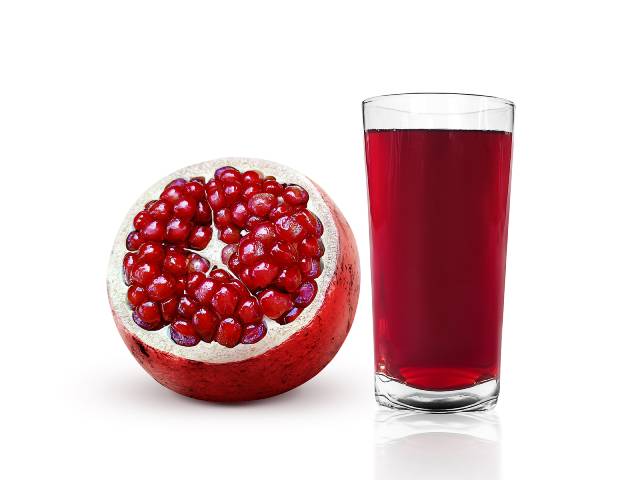
Pomegranate juice is a juice drink often marketed for its polyphenol content.
These polyphenols include high levels of anthocyanins and flavonoids (19).
Pomegranate juice has a deep purple color and a sweet yet slightly tart flavor.
A typical 248g cup of pomegranate juice contains these nutrients (20):
- Calories: 134 kcal
- Carbohydrates: 32.5 g
- Fiber: 0.25 g
- Sugars: 31.2 g
- Fat: 0.72 g
- Protein: 0.37 g
Per cup serving, pomegranate juice also provides reasonable amounts of vitamin K (22% DV), folate (15% DV), potassium (11% DV), and vitamin E (6% DV).
13) Prune Juice
Prune juice is a flavorful juice made with a single ingredient of dried plums.
However, since dried fruit has a much lower water content than fresh fruit, it contains significantly more sugar gram for gram.
As a result, prune juice is an intensely sweet drink with high sugar content. It has an extremely dark purple-to-brown color.
Here are the nutritional values for a 256g cup of prune juice (21):
- Calories: 182 kcal
- Carbohydrates: 44.5 g
- Fiber: 2.56 g
- Sugars: 42.0 g
- Fat: 0.08 g
- Protein: 1.56 g
Prune juice contains high levels of numerous vitamins and minerals.
These include potassium (15% DV), iron (17% DV), manganese (17% DV), vitamin C (12% DV), vitamin K (7% DV), copper (19% DV), riboflavin (14% DV), niacin (13% DV), and vitamin B6 (33% DV).
14) Strawberry Juice
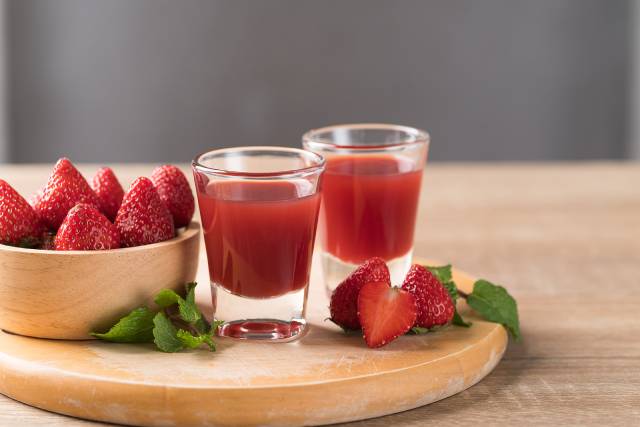
Although it is more difficult to find than many other fruit juices, strawberry juice is another commercially available berry-based juice.
Strawberry juice has a bright red color and a mildly sweet taste.
A 240g cup of strawberry juice provides the following nutrients (22):
- Calories: 91 kcal
- Carbohydrates: 18.7 g
- Fiber: 0.24 g
- Sugars: 18.5 g
- Fat: 1.44 g
- Protein: 0.72 g
In terms of micronutrients, a cup of strawberry juice offers high amounts of magnesium (12% DV), potassium (7% DV), zinc (9% DV), copper (30% DV), vitamin C (30% DV), niacin (7% DV), folate (6% DV), vitamin E (14% DV), and vitamin K (30% DV).
15) Tart Cherry Juice
Tart cherry juice is the juice of Prunus cerasus, a species of cherry known as either sour cherry or tart cherry.
Unlike sweet cherries, tart cherries have a pronounced tart flavor in addition to their sweetness.
This being the case, tart cherry juice has a unique tart and sweet taste.
A 269g cup of tart cherry juice provides the following nutritional values (23):
- Calories: 159 kcal
- Carbohydrates: 36.9 g
- Fiber: –
- Sugars: 32.8 g
- Fat: 1.45 g
- Protein: 0.83 g
Tart cherry juice is also a good source of thiamin (13% DV), copper (12% DV), potassium (9% DV), manganese (7% DV), and magnesium (7% DV).
Benefits and Downsides of Fruit Juice
Fruit juice has nutritional benefits as well as potential downsides.
Here is a quick overview of the main points to understand.
Benefits
Firstly, fruit juice provides a concentrated source of all the vitamins and minerals found in fresh fruit.
Juice is also a significant source of polyphenols and other phytonutrients that may have benefits.
Therefore, like milk products, fruit juice also contributes to vitamin and mineral status.
In contrast, other drinks like water, tea, and coffee typically don’t—or at least not significantly.
Additionally, drinking juice can sometimes be more convenient and less time-consuming than fresh fruit.
An example of this would be pineapple juice compared to cutting, washing, and removing the skin of the pineapple fruit.
Downsides
When making juice, the fiber and structure of the whole fruit are lost.
This is a downside because most people do not consume enough dietary fiber, and juice does not contain it, whereas whole fruit does (28).
Furthermore, systematic reviews of extensive observational studies and clinical trials demonstrate that fiber has numerous benefits for human health (29, 30).
Another drawback of juice is that this lack of fiber and cell walls found within whole fruit leads to a greater glycemic impact. In other words, fruit juice can raise blood sugar to a greater extent than whole fruit (31).
For people looking to boost their fiber intake, vegetable juices typically offer more than fruit juice.
It can also be much easier to over-consume fruit juice than whole fruit. For instance, two cups of orange juice are relatively easy to drink. However, this is the equivalent calorie and carbohydrate content of close to four 140-gram oranges (16, 32)
Consuming two cups of orange juice is much easier than eating four oranges in a row.
Common Questions About Fruit Juice
Here are some answers to common questions about fruit juice and the different available varieties.
Firstly, any fruit juice can contain additional ingredients. This is the case whether the source fruit is orange, cranberries, or any other fruit. Therefore, checking the ingredients label when looking for pure 100% juice is important. Labels like ‘not from concentrate’ or ‘freshly squeezed’ indicate that the juice consists of fresh, pressed juice.
Fruit juice could be “healthy,” or it might not be, depending on the overall diet. For example, if an individual consumes less energy than required from food and has an insufficient vitamin C and potassium intake? In this case, fresh orange juice would likely be a beneficial addition to the diet. In contrast, adding several cups of fruit juice daily to a diet that is already energy and nutrient sufficient would be detrimental and encourage weight gain.
Orange juice is the most common/popular juice in the world. In the United States, apple juice is a close second to orange juice (33).
No. Although juice contains the same vitamins, minerals, and phytonutrients, it doesn’t have the fiber content of whole fruit. Additionally, juice digestion will be quicker due to the lack of volume and structure compared to whole fruit. In this regard, a controlled trial demonstrated that an energy-matched serving of apple is more satiating (filling) than apple juice and led to reduced subsequent energy intake (34).


